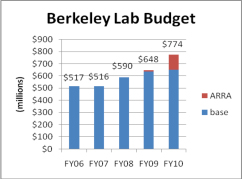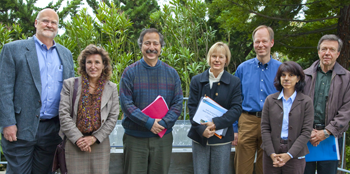

— By Julie Chao
 Members of the Space Advisory Committee discuss options for accommodating Earth Sciences and Environmental Energy Technologies Divisions' program needs.
Members of the Space Advisory Committee discuss options for accommodating Earth Sciences and Environmental Energy Technologies Divisions' program needs.
Even in the age of smart phones, videoconferencing and social media, people are most productive when they have some measure of physical proximity and contact with their co-workers. Our personal workspace needs to be flexible, energy efficient and pleasant to occupy, and it should encourage collaboration and dialogue.
These are the basic principles driving the Laboratory’s new strategic approach to office and lab space, as Berkeley Lab prepares to face a problem that few other employers have these days—an influx of employees, and not enough space to put everyone. In the coming 24 months, the Lab will need to find workstations for up to 500 employees as well as 20,000 square feet of additional laboratory space. Of the 500 needed workspaces, about 300 are for new hires while the remaining 200 are for employees who will be displaced due either to new program activity or the conversion of office space into needed laboratory space.
As Lab Director Paul Alivisatos has said: “We have a big problem regarding space, and I expect everyone at the Lab to do their part to help us solve our problem. No space should be considered off-limits for the changes that we need to make to accommodate program growth.”
 Driving the growth is increased program funding throughout the Lab, especially in the Earth Sciences (ESD), Environmental Energy Technologies (EETD), and Computing Sciences Divisions, as well as the need for Engineering to develop various capabilities needed by the Lab. Another factor is the $264 million awarded to the Lab so far through the American Recovery and Reinvestment Act, or stimulus funding, but even without that, the Lab’s budget has grown, thanks in large part to our key work in areas that are top priorities for the Department of Energy. The Lab’s base budget for fiscal year 2010 is 25 percent larger than it was just three years ago, and that does not include the Recovery Act funding, which is estimated to add another $122 million to this year’s base budget of $652 million.
Driving the growth is increased program funding throughout the Lab, especially in the Earth Sciences (ESD), Environmental Energy Technologies (EETD), and Computing Sciences Divisions, as well as the need for Engineering to develop various capabilities needed by the Lab. Another factor is the $264 million awarded to the Lab so far through the American Recovery and Reinvestment Act, or stimulus funding, but even without that, the Lab’s budget has grown, thanks in large part to our key work in areas that are top priorities for the Department of Energy. The Lab’s base budget for fiscal year 2010 is 25 percent larger than it was just three years ago, and that does not include the Recovery Act funding, which is estimated to add another $122 million to this year’s base budget of $652 million.
EETD’s newly funded National User Facility for Net-Zero Energy Buildings, awarded $15.9 million in Recovery Act funds, may displace about 120 people from the Building 90 complex, including the trailers. The facility will contain a set of test beds that will allow researchers to develop cutting-edge energy efficient building systems.
Additionally, ESD is seeing significant growth, including the award of $7 million over three years in Recovery Act funds for research into enhanced geothermal systems and $20 million over five years for the Center for Nanoscale Control of Geologic CO2, one of 46 Energy Frontier Research Centers funded by the DOE last year. Additionally, ESD’s funding for its climate science research has been growing.
Chief Operating Officer Jim Krupnick acknowledges that a more robust space management process would have reduced the scale of the current problem. Until recently, space management had been a relatively informal process, involving individual divisions interacting with each other and Facilities without sufficient rigor or transparency. “Laboratory management can do better,” he said. “We didn’t have a clear process for actively managing and making decisions about space in a strategic way.”
With this growth the Lab has the opportunity and need to re-examine how space is allocated and modified. Space utilization and distribution will affect the ability and manner in which the Lab addresses current and future initiatives.
The Lab has been working with the Divisions to identify available space to meet both short- and long-term needs. Efforts began last fall, when Krupnick and Facilities Director Jennifer Ridgeway formed teams of scientists and Facilities personnel to evaluate use of both office and laboratory space throughout buildings on the hill and to ferret out empty or underutilized areas. They also visited four companies in the Bay Area, including Google and Network Appliance, to survey their utilization of space.
New Space Advisory Committee to Make Recommendations
 Committee members (l-r) Rich McClure, Helen Cademartori, Ali Belkacem, Natalie Roe, Damir Sudar, Anita Gursahani, and Ernie Majer. With that information in hand, Lab management named Deputy Chief Operating Officer Anita Gursahani as the LBNL Space Manger and chartered the LBNL Space Advisory Committee (known as SPAC). Its members include four scientists — Ali Belkacem (Chemical Sciences), Ernie Majer (ESD), Natalie Roe (Physics) and Damir Sudar (Life Sciences) as chairperson — and two individuals from Operations — Helen Cademartori and Rich McClure — as well as Gursahani. Their first order of business is to recommend to management policies and procedures for managing space, including a metric, or approximately how much space, on average, should be allocated per person, within three months.
Committee members (l-r) Rich McClure, Helen Cademartori, Ali Belkacem, Natalie Roe, Damir Sudar, Anita Gursahani, and Ernie Majer. With that information in hand, Lab management named Deputy Chief Operating Officer Anita Gursahani as the LBNL Space Manger and chartered the LBNL Space Advisory Committee (known as SPAC). Its members include four scientists — Ali Belkacem (Chemical Sciences), Ernie Majer (ESD), Natalie Roe (Physics) and Damir Sudar (Life Sciences) as chairperson — and two individuals from Operations — Helen Cademartori and Rich McClure — as well as Gursahani. Their first order of business is to recommend to management policies and procedures for managing space, including a metric, or approximately how much space, on average, should be allocated per person, within three months.
“The metric will be one component of the space plan,” said Sudar, a deputy director of the Life Sciences Division, which itself is split in two locations and has been struggling with space issues for years. “The plan itself should reflect the strategic plan of the Lab, should still provide a very productive work environment for all people, and should disrupt research as little as possible.”
A metric does not mean that each and every employee will be given the exact same amount of space. Different employees have different needs, depending on their job function. Part of the challenge will be to determine how to apply the metric, or whether divisions should independently decide how to apply the metric.
Still, inevitably, there will be higher density. That could mean fewer enclosed offices, more shared offices, more cubicles, other configurations for open offices, or a combination of all of these. The Laboratory directorate will not be exempt from the effects of the space crunch: it is expected that the 50A fourth floor suites will need to house more people. Eventually, all divisions will be affected.
The moves will not only provide additional workspaces but may reap benefits in improved productivity and collaboration as well. “We hope we can reduce division fragmentation, co-locate groups that need to work together and reduce the distance between individuals’ offices and labs,” said Gursahani.
No decisions will be made without as much input from employees as possible. SPAC is planning to hold a series of brown bag sessions in the auditorium to allow people to voice their ideas and concerns. “We want to make sure we understand employees’ needs and concerns,” said Gursahani. The first brown bag is scheduled for this Thursday, Feb. 18, in the Building 50 Auditorium at noon.
Off-site Options
Meanwhile, Lab management is open to moving groups or divisions off-site if necessary. However, that could result in higher overhead rates. This increase would be in addition to a higher payroll burden rate, which is going up next year due to the restart of employer contributions to the pension plan. The Lab looked into moving the Earth Sciences Division to Emeryville last year but decided against it partly because it would have cost $27 million over five years.
Still, a second campus will be a necessity in the long term. Already, about 20 percent of the Lab’s employees work off-site, spread among four facilities—the Joint Genome Institute in Walnut Creek, the Joint BioEnergy Institute in Emeryville, the West Berkeley Biocenter (Potter St.) and National Energy Research Scientific Computing Center in Oakland. The Lab is now considering several off-site locations in the local area to bring some or all of these groups together on a second campus, partly for financial reasons, but mostly for scientific collaboration. The Lab hopes to narrow down the options to one location by this Spring and then continue discussions.
“We’re missing out on the synergies we could get from having the Life Sciences Division located with JGI and JBEI,” said Krupnick. “Strategically gathering into a single critical mass the offsite research facilities that won’t fit onto the hill would allow for enormous opportunities in expanded scientific collaboration, a greater sense of lab community, and improved efficiencies.”
The Lab is very fortunate to be undergoing expansion while many other institutions are contracting and laying off personnel. With thoughtful planning and preparation for the near term as well as long term, we will insure a bright and productive future for us all.
Additional information:
· LBNL Space Advisory Committee (SPAC) Charter
· Send questions, comments or suggestions to the Space Advisory Committee.
Photos by Roy Kaltschmidt
Today at Berkeley Lab is produced by Public Affairs' Communications Department